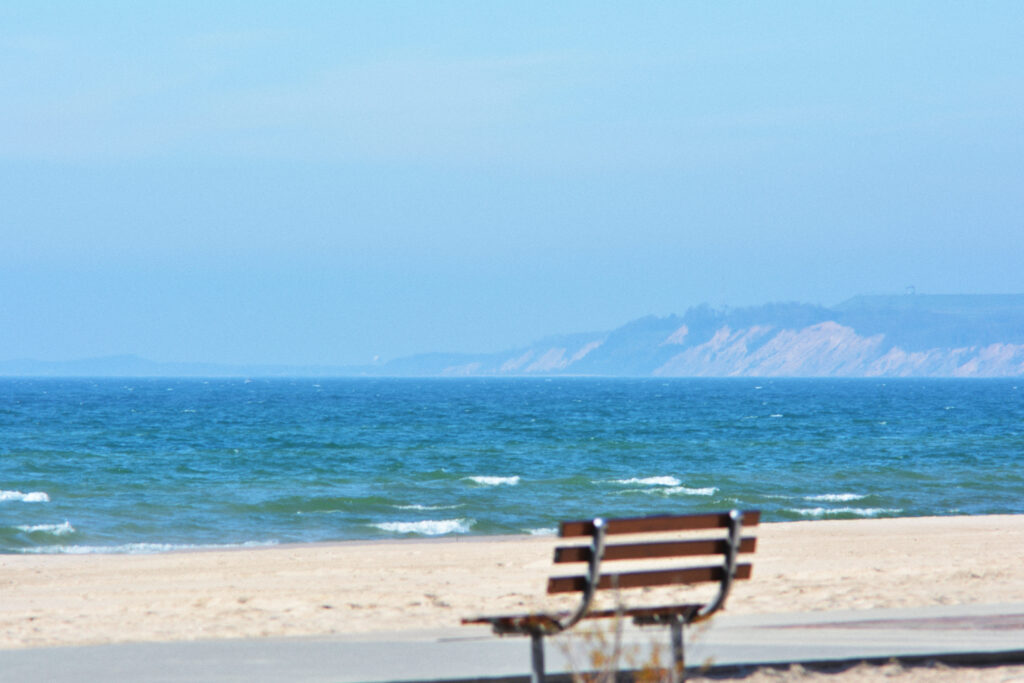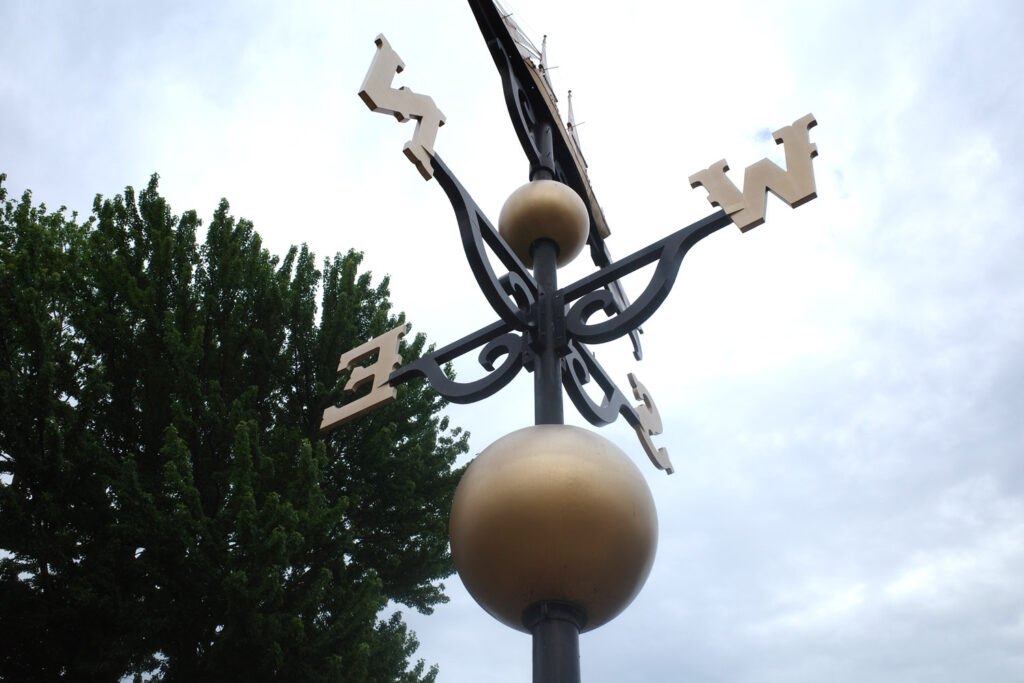Where is Northern Michigan? That’s the question. Determining the boundary isn’t geographical alone. There are cultural factors. There are sociological factors. There is the question of population. There is the question of vacation. Simply put, Northern Michigan is a vibe.
Of course, if you want to conduct a full cultural, geographical, and sociological study, you can break down every crack and corner, and detail your results in a highly elaborate color-coordinated map. But all of this can become overly convoluted, with regions that overlap and cultural distinctions that obfuscate the clearest delineation. Ultimately, at the most basic level, there are two Michigans; and no, they’re not the Upper Peninsula and the Lower Peninsula, but Northern Michigan and Southern Michigan.
Take out a map and find Linwood. It’s a small town on Lake Huron. This is the easternmost point on the southern border of Northern Michigan. From Linwood, the line runs west—passing south of Stanford and just north of Midland, south of Mt. Pleasant and just north of Shepherd. Next, the border dips south—running right alongside Edmore and Greenville, finally passing just south of Grand Rapids before heading over to the lake south of Zeeland and Holland. Geographically speaking, this is it.
I can hear the confused protests. “Holland isn’t part of the North!” “It’s not split 50/50!” “Why is Northern Michigan so much bigger than Southern Michigan?!” That’s because, to truly understand where Northern Michigan separates from Southern Michigan, you need to consider more than geography.
Where is Northern Michigan? Simply put, Northern Michigan is a vibe.
Like a teeter totter, the boundary tilts with the eastern end raised higher than the western. The Detroit area is a behemoth. The population density, the pace of life, and the industry all impact culture and lifestyle profoundly. Metro Detroit’s cultural and social effects reach much farther north on the east side of the state. For this reason, Saginaw and Bay City are not a part of Northern Michigan, despite being farther north than Holland. Northern Michigan begins outside of Metro Detroit’s reach and orbits a pole other than Metro Detroit.

What defines the essence of Northern Michigan isn’t easily written down, but you can feel it in your bones. It’s the sum of 10,000 parts that make up a whole. When you drive from a suburb of Detroit to any place above the boundary line, you feel the difference. The exits get farther apart, the cars thin out, the billboards fade, the drivers are nicer. It comes slowly, then all of a sudden. And the farther beyond the line you travel, the more pronounced the difference becomes. Fewer stop lights, less noise, further stores, taller trees, deeper woods, larger fields, emptier lakes, rougher water, smaller towns.
If your mind races in the South, it is relieved in the North. In Northern Michigan, you don’t hear the menacing sound of a rumbling stereo rolling down the road outside the CVS while you wait in line behind 12 other sorry souls. Instead, you look over the glassy water of a long lake with only the sound of the morning birds. In Northern Michigan, you can drive on cruise control for an hour without ever touching the brake. There is no rush hour. The stars are brighter in the cold night. The light pollution from the southeast doesn’t block out the heavens. The faint sound of coyotes howling in the night is eerie and beautiful.
When people from the southeast side of the state say they are going “Up North,” where is that? That’s Northern Michigan. Where are the beaches and lake towns where everyone goes on vacation? That’s Northern Michigan. That Michigan is a slower Michigan. There, you aren’t aware of the newest cultural developments. You aren’t racing toward the future. You are in a more natural world. You are on another track. No new restaurants to choose from on any given night. No strip malls with the same stores. Sometimes, places close for months at a time while waiting for summer to come. There are liquor stores in the middle of nowhere, you can buy a license for hunting pheasant at a gas station where you pump first and then pay inside after. Snowmobile tracks that run across the road every February. These same snowmobiles race through the woods on a winter’s day. You can see their lights through the pines as you drive on US-10 on a freezing Saturday night. The school gives time off for opening day of deer season. There are bumper stickers plastered on trucks that read, “Why do they call it tourist season if you can’t shoot them?” You can get a Vernors fountain pop at McDonalds.
There aren’t boatloads of new arrivals every year. People don’t move to the North like they move to the South. There aren’t countless new developments always being built. More Michiganders and fewer out-of-staters. Some trickle into Grand Rapids (the southernmost city in Northern Michigan), but it’s not the same density. As soon as you drive 10 miles north of GR, you’re in Northern Michigan. It’s native Michiganders from there on out, no matter how far you drive.
Cars are not the same in the North. The North begins where the Illinois plates start to drop off. People from Chicago visit South Haven and Saugatuck, but they don’t really go much farther. You might see a straggler farther north, maybe in Holland or Grand Haven, but it’s that southwest corner where they generally stay. They don’t make it to Frankfort or Charlevoix. They aren’t strong enough. You see different kinds of cars in the South. For every one BMW in Northern Michigan, there are 50 BMWs in Southern Michigan. That might not be entirely statistically correct, but it is directionally correct. There aren’t BMWs, Mercedes, or Teslas in Northern Michigan. There’s Ford, Dodge, and Chevy. There are Tesla charging stations in Northern Michigan Meijer parking lots, but no one uses them. They sit there all day, empty.

The way the northern Michigander responds and reacts is different than the southern Michigander. The manners are different. The northern Michigander doesn’t live among the noise and chaos of the South. He hasn’t turned himself over to the metro sprawl. And for that reason, he is more alone with himself and he can be quieter. He lets you talk before he talks. He gives you the benefit of the doubt. He doesn’t question you, he doesn’t press you. He assumes you aren’t trying to pull one over on him. If he has something negative to say, he will find a way to say it softly. He might say it so delicately that you might not even be aware he said it. But if you speak his language, you understand the nuances that are often only picked up by other native speakers. In this way, he is less direct and more amenable.
But in other ways, the northern Michigander can be gruff and without pretense. A gruffness that comes from comfortability and an assumption of some degree of shared culture. Both the kindness and the gruffness are different sides of the same coin, born of being more alone and with others who know what it means to be more alone. The northern Michigander is less concerned with keeping up appearances. He isn’t always trying to outdo his neighbor. He is more likely to work in a small building than a supersized office park. He has property, not a lawn. He has a “wood guy” who drops off wood every fall for his wood burning stove.
The southern Michigander is direct in the way that higher population density requires. Things are happening where he lives, and he knows it. He spends hours in traffic with people who have little patience. There is no time for nuance or beating around the bush. He knows there is some place open 24 hours. If he is from Metro Detroit, he went to the mall every weekend, and he knows what “Coney” means. The northern Michigander has no idea what that is. The Southerner pays through bullet proof glass more than he should. He is more skeptical, he is in the blender of the South where nuances of manner and shared assumption get submerged in the mass. In the South, the Red Wings are bigger. People reminisce about “The Joe.” Nobody talks about “The Joe” in Northern Michigan.

Northern Michigan means the end of the line. There is nothing up there, just woods and lake, beauty and nature. Once you leave Grand Rapids on your way to the bridge, it’s woods, woods, and more woods. You eventually get to Traverse City, but then as soon as you leave it’s empty again. You cross the bridge to the U.P. and it only thins out more. It all starts at Grand Rapids. Look at a map, and it’s clear that Grand Rapids is not exactly far north; it’s closer to Detroit than it is to Mackinac, after all. But it is decidedly part of Northern Michigan. It’s all in the vibe. Grand Rapids has grown significantly in recent years, but no Michigander groups Grand Rapids with Detroit. People do, however, group Ann Arbor with Detroit. And then there’s Grand Rapids with Holland. This tells you all you need to know about the clear cultural distinction of Grand Rapids and Holland as a bloc apart from Ann Arbor and Detroit.
Grand Rapids isn’t the northernmost city of the South; it’s the southernmost city of the North. In Grand Rapids, you can walk into a coffee shop and a majority of the people might come from counties west of Grand Rapids, where the towns have populations fewer than 10,000. You can still head over to Grand Haven for a day trip to the beach. You are drawn west and to the water. The beach is only 45 minutes away. (In Metro Detroit, you can drive for 45 minutes through suburbs alone.) You aren’t going to see bars on windows; it isn’t Detroit. And all of those Northern Michigan manners can still be felt in GR if you know where to look.
There are, of course, smaller distinct regions within (and sometimes stretching across) these two broad categories of North and South. Central Michigan is a distinct region, and the same is true of West Michigan and the U.P. There is also a region that could be considered the Deep North, which is the northernmost region of the lower peninsula. The Deep North might begin where people start to use the word “downstate.” Or, there are regions that don’t easily align with the cultural blocs that define the two regions of North and South. The thumb, for example, is its own place with its own distinct attitude. With a rich farming history, yet close in proximity to the hubs of automotive manufacturing, the culture of the thumb is born of a tough mix of industry and agriculture. It’s not the suburbs of Detroit, yet it’s not the empty forests of the North. It simply can’t be included in the North, though it stretches north and is distinct from Ann Arbor. It’s just too close to Detroit.
Northern Michigan begins after the shadow of the southeast has disappeared. The traffic fades and the chaos dissipates. It’s where you feel the seasons in a different way. It’s in the weather; the winter is colder. But you feel it most in the people. The towns empty out after Labor Day. School starts and all the visitors go back to the South. You have the North to yourself. You feel the world slowing down. Nature heals, and life is quiet. Northern Michigan is Michigan as it is meant to be.
O.W. Root is a writer based in Northern Michigan, with a focus on nature, food, style, and culture. Follow him on X at @NecktieSalvage.




